Diagnosing steering wander complaints can become a headache for any import alignment technician, often because he can’t duplicate the complaint on a test drive.
But, after the car leaves the shop, the presence of road camber or crown, crosswinds, and vehicle load or load distribution will often aggravate steering wander complaints caused by mechanical faults. As frustrating as diagnosing steering wander complaints might be, most can be solved by thoroughly inspecting the physical condition of the vehicle. In the following text, I’ll cover some of the most common causes of steering wander and how to detect them during an undercar inspection.
THE DRY PARK TEST
The conventional “dry park” test consists of a helper starting the engine and turning the steering wheel from lock to lock while the alignment tech looks for worn steering linkage components or flexing in the steering gear and idler arm mounts. See Photo 1.
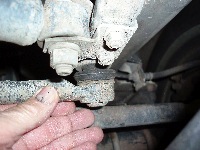
If, for example, movement is detected in the steering rack mountings, the mountings should be inspected and replaced, if needed. When testing a truck equipped with a conventional steering gear and parallelogram steering linkage, check the steering gear and idler arm mountings for excessive flexing. Next, inspect the steering shaft coupler, slip joint and universal joint for excessive play. See Photo 2.
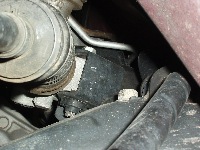
Steering stabilizers basically dampen road shock through the steering linkage and give the steering wheel a more solid feel. Always check for fluid leakage and physical damage. If the stabilizer has accumulated a lot of miles, physically remove it from the chassis and test it by hand for wear, binding and resistance. See Photo 3.
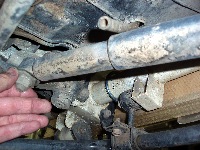
Last, check the ball joint ends for wear. Most short- and long-arm (SLA) suspensions incorporate a load-carrying ball joint that is not preloaded and a follower ball joint that is preloaded to maintain precise caster and camber angles. Strut suspensions use the upper support bearing to carry the weight of the vehicle and the lower ball joint to maintain alignment.
STEERING GEAR OVER-CENTER
When the steering wheel is centered, the pitman arm and idler arms should be parallel to the vehicle centerline. Remember also that conventional steering gears have a “high point” that should be at nearly zero gear lash when the gear is centered. If the steering gear has excessive lash, return the gear to its center position and adjust to specification. In addition, check for wear in the steering gear itself.
In some cases, a minor over-center adjustment will remove excessive play in a conventional steering gear. Always make the over-center adjustment with the steering gear in a centered position. If the pitman arm shaft bushings are worn, the steering gear should be repaired or replaced.
Last, late-model imports use steering position sensors to relay a steering center signal to the PCM. Because this signal serves a variety of operating strategy issues in both normal steering and vehicle stability control functions, the steering sensor must be fully operational and correctly adjusted. Always check for steering-related DTCs with a professional scan tool before jumping to any diagnostic conclusions about the causes of steering wander.
TIRE APPLICATIONS
Because late-model vehicles incorporate features like anti-lock braking and vehicle stability control into their on-board electronics, it’s doubly important to have the OE-specification tire size and ratings on the vehicle. It’s also preferable to have the same brand name and quality rating of tires on all four wheels and that the tires have at least 30-50% of their original tread.
The problem with mixing tires is that the tread and casing designs differ. Instances of steering pull might be caused by one tire producing more rolling resistance than its companion. An unstable feel in the steering wheel might be caused by differences in sidewall flex between two axle set tires. Tires should also be replaced in sets of four because tires become harder and less flexible as they age. While all of the above issues sound minor in nature, the highly sophisticated steering and suspension systems used on today’s modern import vehicles are very sensitive to tire casing and tread issues.
CUSTOM WHEELS
Although custom wheels are very popular, they can also aggravate steering wander complaints if they have more offset than the OE wheels or if the wheels are mismatched. To understand why, we need to understand steering geometry. A line drawn through the upper and lower ball joints (king pin angle or KPI) should intersect at or near the center of the tire tread. The purpose of KPI is to reduce steering wheel shock and to allow the wheel to pivot on its natural center.
Negative toe angle, in particular, will create a steering wander complaint. Although the static alignment might be in the positive ranges, excessive wheel offset moves the vehicle’s weight farther out on the spindle, which tends to push the dynamic wheel alignment into the negative ranges. Excessive wheel offset also causes premature wear in wheel bearing, suspension and steering linkage parts.
BUMP STEER
Bump steer is a racing term describing a toe angle change that occurs with a change in suspension height or attitude. The objective of most steering geometry engineers is to reduce the toe angle change that occurs as the steering and suspension systems travel through their normal ranges. Despite those efforts, changes in suspension height do affect toe angle which, in turn, increases steering wander. See Photo 4.
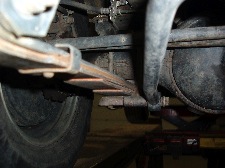
To verify the influence of suspension height or attitude on toe angle, move the suspension system through its normal range of extension and compression. If the toe angle moves from specification into the negative or toe-out range as the vehicle is lifted a few inches, then the steering wander condition can be caused by something as simple as the driver of a passenger vehicle loading the trunk full of heavy goods or attaching a trailer with a high tongue weight on the back of a light truck or SUV. See Photo 5.
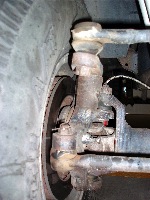
Depending upon vehicle application, the simplest cure for bump steer is to install aftermarket air bags or air-assisted shock absorbers to restore the suspension height when loaded. In other cases, the vehicle might have a self-leveling system that no longer functions correctly. Some light truck applications might also require an aftermarket kit to increase the load capacity of the rear springs.
REAR STEER
A common mistake is assuming that the toe angle on solid rear axle housings used in light trucks is correct. An axle with a slight toe-out condition will cause a steering wander complaint. While a few skilled drivetrain repair shops can correct minor amounts of axle housing misalignment, replacement might be the best option if the axle housing is bent due to a collision impact. A solid rear axle with worn spring bushings, or broken center bolts or trailing arm bushings and axle mounts, will also allow the axle to change its centerline of thrust as the vehicle travels over the road. This, in turn, causes the steering gear to travel off-center and cause steering wander. See Photo 6.
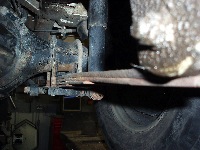
‘CROWNED ROAD’ ISSUES
Civil engineers build a crown or camber into a road to accelerate water drainage during rainy or snowy weather. Unfortunately for the alignment tech, road crown causes many vehicles to steer away from the center of the road. If you visualize the situation, it’s easy to see that the weight of the vehicle is being carried by the right-hand outside edges of the tires on a crowned road.
This change in tire loading actually pivots the tires to the right and causes an alignment pull. All too often, the driver might interpret normal steering pull as steering wander, especially if the amount of road crown varies or if a crosswind condition is present.
According to my experience, the simplest solution to the road crown dilemma is to correct the loading on the tire by adding a slight amount of positive camber — perhaps a 1/4 degree — to the left suspension and subtracting an equal amount from the right suspension. The camber angle bias will produce fewer pulling complaints than will a caster angle bias on flatter roadways.












